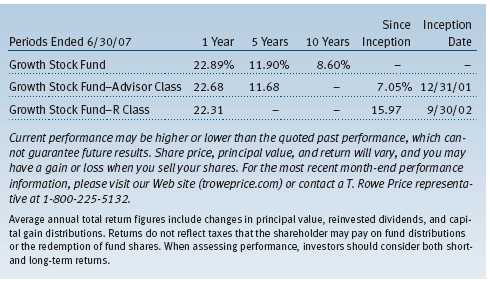Item 1: Report to Shareholders| Growth Stock Fund | June 30, 2007 |
The views and opinions in this report were current as of June 30, 2007. They are not guarantees of performance or investment results and should not be taken as investment advice. Investment decisions reflect a variety of factors, and the managers reserve the right to change their views about individual stocks, sectors, and the markets at any time. As a result, the views expressed should not be relied upon as a forecast of the fund’s future investment intent. The report is certified under the Sarbanes-Oxley Act, which requires mutual funds and other public companies to affirm that, to the best of their knowledge, the information in their financial reports is fairly and accurately stated in all material respects.
REPORTS ON THE WEB
Sign up for our E-mail Program, and you can begin to receive updated fund reports and prospectuses online rather than through the mail. Log in to your account at troweprice.com for more information.
Manager’s Letter
Fellow Shareholders
Before I review the fund’s performance, the investment landscape, or any of the changes I made in the portfolio over the past six months, I would like to address the managerial change that will take place as I step down as portfolio manager of the Growth Stock Fund on October 1, 2007. After 10 years as the manager of this fund, I am looking forward to a new challenge: I have accepted the position as portfolio manager of the firm’s International Stock Fund. I want to thank you, our shareholders, for entrusting me with your hard-earned dollars, and I want you to know that I appreciate your confidence in me and in T. Rowe Price.
HIGHLIGHTS
• Stock markets around the world generated solid first-half results. Large-caps narrowly outperformed small-caps, and growth stocks distanced their value counterparts across all market capitalizations.
• Your fund outperformed the S&P 500 Stock Index, the Russell 1000 Growth Index, and the Lipper Large-Cap Growth Funds Index for the past six and 12 months.
• The information technology and telecommunication services sectors were the best year-to-date performers in the portfolio.
• We believe that growth stocks exposed to strong international markets can continue to produce solid earnings gains into 2008.
As you may recall from the letter we sent to shareholders a few months ago, Rob Bartolo will become the chairman of the fund’s Investment Advisory Committee and will assume the day-to-day management responsibilities as portfolio manager. I am confident that I am leaving our fund in good hands. Rob and I have worked together for several years, and he has been a member of this fund’s Investment Advisory Committee since 2005. Rob has been an important contributor to our performance over the past five years, first as an analyst and later as the co-manager of the T. Rowe Price Media & Telecommunications Fund. I believe he is extremely well-suited for his new role.
In recent months, Rob and I have worked together to ensure a smooth transition, and we will continue to do so for the foreseeable future. I will remain a member of the Growth Stock Fund’s Investment Advisory Committee. The committee consists of talented and seasoned investment professionals, including research analysts and senior portfolio managers. I expect this team to remain largely intact after the transition.
Over the past several months, we have met with a number of the fund’s institutional clients to discuss the transition of managerial duties. What we told them about the portfolio’s investment process can be summed up as follows:
• The fund’s investment philosophy will continue as it has since Thomas Rowe Price, Jr., began the fund 57 years ago. We will rely on the strength of our independent research group to conduct rigorous research and analysis.
• We will continue to select companies for the portfolio that exhibit above-average earnings and free cash flow growth, while maintaining an awareness of the importance of valuation, which contributes to our heritage of intelligent risk taking.
• We will continue to be a longer-term investor and not a “renter” of stocks. We recognize that we are a fiduciary—entrusted as a caretaker of our clients’ financial goals—and experience has taught us that the long-term view is best for building and protecting our clients’ assets.
PORTFOLIO PERFORMANCE
The Growth Stock Fund posted strong gains for the six and 12 months ended June 30, 2007, advancing 8.63% and 22.89%, respectively. As shown in the table, these results outperformed the S&P 500 Index, the Lipper Large-Cap Growth Funds Index, and the Russell 1000 Growth Index in both periods. (Results for Advisor and R Class shares were slightly lower, reflecting their higher expense ratios.)
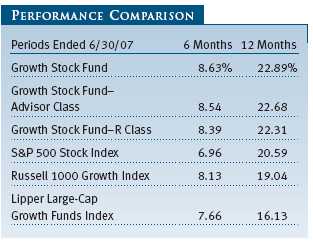
Over the recent six-month period, every sector except utilities (where we own one stock) posted positive returns. Stock selection was the main reason for outperforming the benchmark S&P 500 Index—our choices among telecommunication services and consumer discretionary shares were the largest contributors to relative results. We also benefited from an overweight in the energy sector. Stock selection and an overweight allocation in the industrials and business services sector detracted from relative returns. Our comparison with the benchmark was also hurt by stock selection in the health care sector, especially biotechnology and pharmaceuticals, but our underweight allocation was beneficial.
The Growth Stock Fund has delivered consistently strong long-term performance compared with its peer group. Lipper ranked the fund in the top 3% of its large-cap growth funds universe for the one-, three-, and five-year periods and in the top 4% for the 10 years ended June 30, 2007. (Based on cumulative total return, Lipper ranked the Growth Stock Fund 18 out of 717, 15 out of 614, 9 out of 494, and 7 out of 193 funds for the 1-, 3-, 5-, and 10-year periods ended June 30, 2007, respectively. Past performance cannot guarantee future results.)
MARKET ENVIRONMENT
Fortunately, we are stock pickers and not economists. For the last several years, we’ve believed that U.S. economic growth would slow to the point that it would cause global demand to wane. Although we were right about the slowdown in the U.S. consumer, we were way off base about the impact it would have around the world.
Economic growth outside the U.S. (with the exception of the U.K.) remained robust. Developed and emerging markets around the globe are experiencing boom times, and that growth, coupled with domestic issues relating to the subprime housing market, have caused the U.S. economy to lag; this in turn has applied downward pressure on the dollar. This scenario has left the Federal Reserve in somewhat of a bind as moderately rising inflation, largely caused by escalating global demand for commodities, makes it harder to lower interest rates to deal with the housing market. Therefore, we believe U.S. consumer spending will remain subdued for a while longer, and companies positioned to benefit from surging overseas economies should continue to prosper.
Stock markets around the world performed well in the first half of the year. Large-caps narrowly outperformed small-caps, and growth stocks distanced their value counterparts across all market capitalizations, which was a favorable turnaround from recent periods for the large-cap-focused Growth Stock Fund. Corporate profit growth slowed from the double-digit pace of the past few years, but not as much as originally anticipated. Better-than-expected earnings, substantial merger activity, and signs of an economic pickup in the second quarter (following an anemic first quarter) provided a lift to the stock market. However, volatility increased during the six-month period, exemplified by sharp downturns in late February and mid-June in response to higher energy prices and problems in the subprime mortgage market.
In the large-cap universe, as measured by the S&P 500, the economically sensitive energy and materials sectors performed best. Telecommunication services stocks also did well. Shares of financial companies lagged significantly, falling on concerns about the subprime mortgage market and a second-quarter spike in longer-term interest rates. Consumer discretionary and consumer staples stocks also trailed, as high gasoline prices weighed on spending.
PORTFOLIO REVIEW
The information technology sector, which accounts for more than 23% of the portfolio’s total net assets (up from approximately 21% six months ago), was the largest contributor in the first half. Led by Juniper Networks and Corning, our communications equipment industry holdings generated the best performance within the sector. Juniper is a global designer and manufacturer of secure networking solutions that connect public and private networks across various media, including voice, video, and data. Juniper’s new products have enjoyed commercial success, and its stock has climbed about 30% over the past four months. Corning’s shares posted similar gains. The company is the world’s largest manufacturer of ultrathin liquid crystal display glass used in flat-screen TVs and computers. Management decided to restrict production last year, which has improved pricing and strengthened margins. Additionally, Corning’s financial footing has improved dramatically over the past six months, prompting the major agencies to upgrade the firm’s credit rating.
Accenture and Google were the top gainers in the information technology sector and among the portfolio’s best contributors for the past six months. Accenture is a leading management consulting firm that is benefiting from strong global economic growth and the increase in merger and acquisition activity. The company’s shares surged in response to its solid revenue and earnings gains, and we believe the firm can continue to produce above-average growth for the foreseeable future. We have a large position in Google (the fund’s third-largest holding on June 30), and we added to our position during the period. The company has benefited from the growth in online advertising and has generated market share gains. Although we have a much smaller stake in Apple, its shares rose more than 40% in the past six months, making it one of our 10-best gainers for the period. The computer and “infotainment” products maker generated welcome media coverage with the launch of its highly publicized iPhone and made enhancements to its iPod and Macintosh.

The telecommunication services sector was the fund’s second-best performer for the past six months. Three of the fund’s 10 largest contributors were Rogers Communications, America Movil, and Bharti Airtel, which we will cover in the foreign stocks section of the letter. During the period, we added significantly to our telecom holdings, including new positions in MetroPCS and Leap Wireless, a pair of regional wireless services providers that serve two to three million customers each. Both offer low-cost service and should be able to take market share in their respective regions. We think that a merger is possible at some point and would benefit both firms. We also added American Tower, an owner, operator, and developer of communication tower sites in the U.S., Mexico, and Brazil. The stock was a reasonable first-half performer, and we believe its growth will reaccelerate into 2009.
Online retailer Amazon.com was our best contributor for the last six months. The stock was almost flat in the first quarter and then rocketed higher in the second as sales and operating margins expanded. Amazon has made the transition into higher-margin businesses, including digital media distribution, and reduced its technology and content spending. Although the consumer discretionary sector was a solid contributor overall, it was home to several of our most disappointing investments. The housing market was particularly weak as rising interest rates and slack economic conditions curbed enthusiasm for homebuilders, including Lennar. We believe sentiment for the company and the industry will begin to improve as the economy regains momentum, and we remain optimistic about the longer-term prospects for the stock. Specialty retailers Lowe’s and Bed Bath & Beyond, two new holdings in the first half, were among our worst performers. We jumped out of the frying pan and into the fire with our sale of Home Depot and concurrent purchase of Lowe’s. While we like Lowe’s prospects more than Home Depot’s at this point in the economic cycle, both do-it-yourself home improvement retailers posted first-half losses.

The portfolio generated gains in the financials and health care sectors, but we had few top contributors and several of our larger detractors. In aggregate, we trimmed our combined holdings in these two sectors from 36.8% on December 31 last year to 30.4% of assets at the end of the reporting period. In financials, Countrywide Financial, Citigroup, and UBS were among our largest detractors. Countrywide was severely impacted by economic and housing market weakness. However, the good news, and the reason we added to our position in the first half, is we believe the company will be in great shape once we come out of the housing downturn. We added to UBS during the period and trimmed a bit of our large stake in Citigroup.
In health care, we reduced our positions in Novartis and Amgen as their stocks declined and product delays or other issues gave us reason for concern. In the case of longtime winner UnitedHealth Group, the company is facing a rising medical loss ratio (a measure of its profitability), and its enrollment has slowed. Although we like the company’s free cash flow, its position in the market, and its high-quality management team, we reduced our position to 0.8% from more than 2.3% six months ago.
One of the competitive advantages that we utilize at T. Rowe Price is our deep and talented global analyst team. As growth accelerated in international markets, we benefited from team members’ insights and were able to reap gains from several of our overseas holdings. Our foreign stocks accounted for about 17% of the portfolio at the end of the reporting period, little changed from six months ago.
As we previously mentioned, international wireless investments were very rewarding. Your fund’s future manager, Rob Bartolo, steered me to Rogers Communications (Canada), Bharti Airtel (India), and America Movil (Mexico), three of the fund’s 10 largest contributors for the past six months.
In addition, our investment in BHP Billiton (Australia), a leading mining, drilling, and natural resources processing company, produced solid gains. We also benefited from companies exposed to the faster economic growth outside the U.S., such as InBev (Belgium) and Hon Hai Precision (Taiwan). InBev derives more than half of its earnings from its operations in emerging markets, and Hon Hai, which has about 100,000 employees in China, is the world’s largest contract manufacturer of personal computers and electronics products.
OUTLOOK
While the U.S. economy is slowing and consumer spending will probably stay subdued for some time, international economic growth remained strong. Although these growth rates will inevitably slow, we believe that companies exposed to strong international markets can continue to produce solid earnings gains into 2008. Per our charter, we attempt to own companies that can generate double-digit earnings growth and have tilted the portfolio toward the world’s fastest-growing markets.
One of my biggest concerns is that commodities are in tight supply, which could lead to rising prices and ultimately inflationary pressures until new production can be added. We remain confident that our large-cap growth companies can effectively deal with the higher cost of raw materials and potentially rising inflation and interest rates. Assuming that we can navigate these concerns, the Growth Stock Fund should continue to perform reasonably well.
As always, we will work diligently on your behalf to find companies that are positioned to grow in this environment.
Respectfully submitted,

Robert W. Smith
Chairman of the fund’s Investment Advisory Committee
July 19, 2007
The committee chairman has day-to-day responsibility for managing the portfolio and works with committee members in developing and executing the fund’s investment program.
RISKS OF STOCK INVESTING
The fund’s share price can fall because of weakness in the stock markets, a particular industry, or specific holdings. Stock markets can decline for many reasons, including adverse political or economic developments, changes in investor psychology, or heavy institutional selling. The prospects for an industry or company may deteriorate because of a variety of factors, including disappointing earnings or changes in the competitive environment. In addition, the investment manager’s assessment of companies held in a fund may prove incorrect, resulting in losses or poor performance, even in rising markets.
GLOSSARY
Dividend yield: The annual dividend of a stock divided by the stock’s price.
Free cash flow: The excess cash a company is generating from its operations that can be taken out of the business for the benefit of shareholders, such as dividends, share repurchases, investments, and acquisitions.
Lipper indexes: Fund benchmarks that consist of a small number (10 to 30) of the largest mutual funds in a particular category as tracked by Lipper Inc.
Price/book ratio: A valuation measure that compares a stock’s market price with its book value, i.e., the company’s net worth divided by the number of outstanding shares.
Price/earnings ratio (P/E): A valuation measure calculated by dividing the price of a stock by its current or projected earnings per share. This ratio gives investors an idea of how much they are paying for current or future earnings power.
Russell 1000 Growth Index: A market capitalization-weighted index of those firms in the Russell 1000 with higher price-to-book ratios and higher forecasted growth values.
S&P 500 Stock Index: An unmanaged index that tracks the stocks of 500 primarily large-cap U.S. companies.
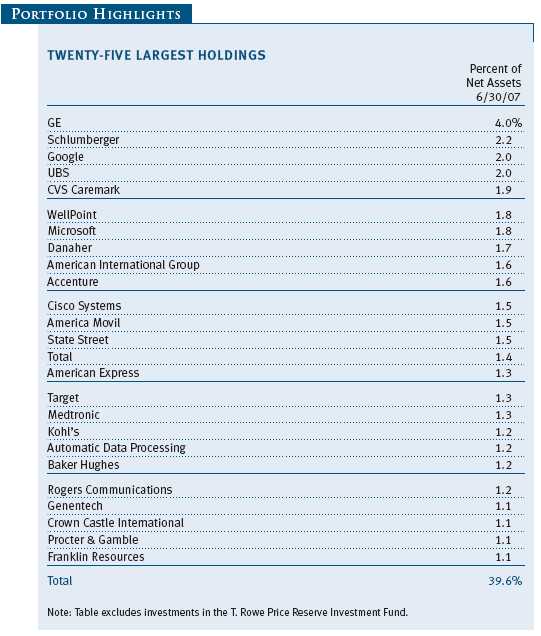

Performance and Expenses
This chart shows the value of a hypothetical $10,000 investment in the fund over the past 10 fiscal year periods or since inception (for funds lacking 10-year records). The result is compared with benchmarks, which may include a broad-based market index and a peer group average or index. Market indexes do not include expenses, which are deducted from fund returns as well as mutual fund averages and indexes.

| AVERAGE ANNUAL COMPOUND TOTAL RETURN |
This table shows how the fund would have performed each year if its actual (or cumulative) returns had been earned at a constant rate.

As a mutual fund shareholder, you may incur two types of costs: (1) transaction costs, such as redemption fees or sales loads, and (2) ongoing costs, including management fees, distribution and service (12b-1) fees, and other fund expenses. The following example is intended to help you understand your ongoing costs (in dollars) of investing in the fund and to compare these costs with the ongoing costs of investing in other mutual funds. The example is based on an investment of $1,000 invested at the beginning of the most recent six-month period and held for the entire period.
Please note that the fund has three share classes: The original share class (“investor class”) charges no distribution and service (12b-1) fee; Advisor Class shares are offered only through unaffiliated brokers and other financial intermediaries and charge a 0.25% 12b-1 fee; R Class shares are available to retirement plans serviced by intermediaries and charge a 0.50% 12b-1 fee. Each share class is presented separately in the table.
Actual Expenses
The first line of the following table (“Actual”) provides information about actual account values and expenses based on the fund’s actual returns. You may use the information in this line, together with your account balance, to estimate the expenses that you paid over the period. Simply divide your account value by $1,000 (for example, an $8,600 account value divided by $1,000 = 8.6), then multiply the result by the number in the first line under the heading “Expenses Paid During Period” to estimate the expenses you paid on your account during this period.
Hypothetical Example for Comparison Purposes
The information on the second line of the table (“Hypothetical”) is based on hypothetical account values and expenses derived from the fund’s actual expense ratio and an assumed 5% per year rate of return before expenses (not the fund’s actual return). You may compare the ongoing costs of investing in the fund with other funds by contrasting this 5% hypothetical example and the 5% hypothetical examples that appear in the shareholder reports of the other funds. The hypothetical account values and expenses may not be used to estimate the actual ending account balance or expenses you paid for the period.
Note: T. Rowe Price charges an annual small-account maintenance fee of $10, generally for accounts with less than $2,000 ($500 for UGMA/UTMA). The fee is waived for any investor whose T. Rowe Price mutual fund accounts total $25,000 or more, accounts employing automatic investing, and IRAs and other retirement plan accounts that utilize a prototype plan sponsored by T. Rowe Price (although a separate custodial or administrative fee may apply to such accounts). This fee is not included in the accompanying table. If you are subject to the fee, keep it in mind when you are estimating the ongoing expenses of investing in the fund and when comparing the expenses of this fund with other funds.
You should also be aware that the expenses shown in the table highlight only your ongoing costs and do not reflect any transaction costs, such as redemption fees or sales loads. Therefore, the second line of the table is useful in comparing ongoing costs only and will not help you determine the relative total costs of owning different funds. To the extent a fund charges transaction costs, however, the total cost of owning that fund is higher.
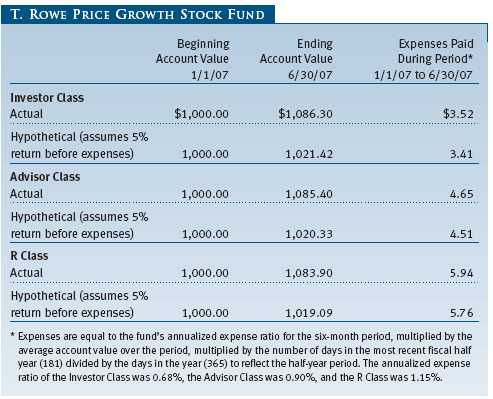
Unaudited

The accompanying notes are an integral part of these financial statements.
Unaudited
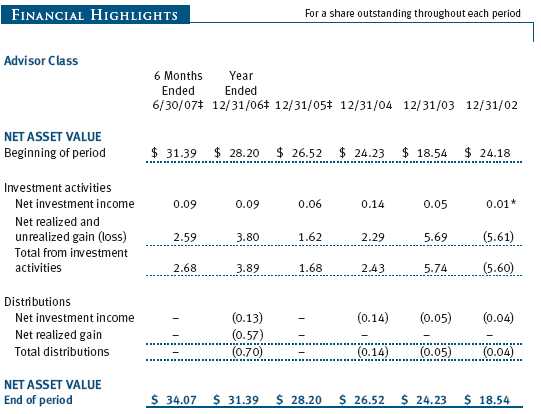

The accompanying notes are an integral part of these financial statements.
Unaudited

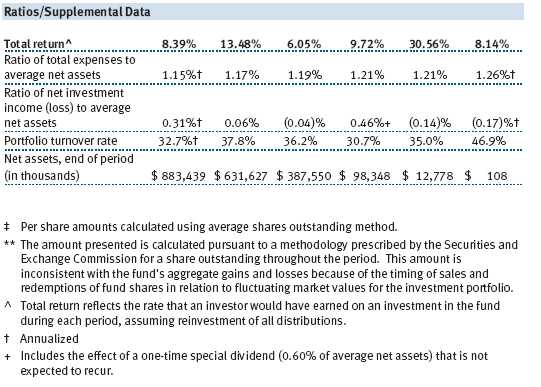
The accompanying notes are an integral part of these financial statements.
Unaudited
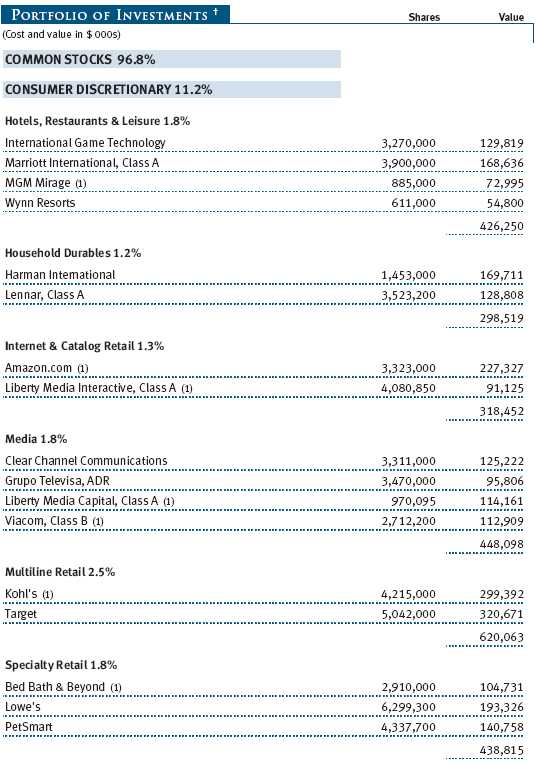
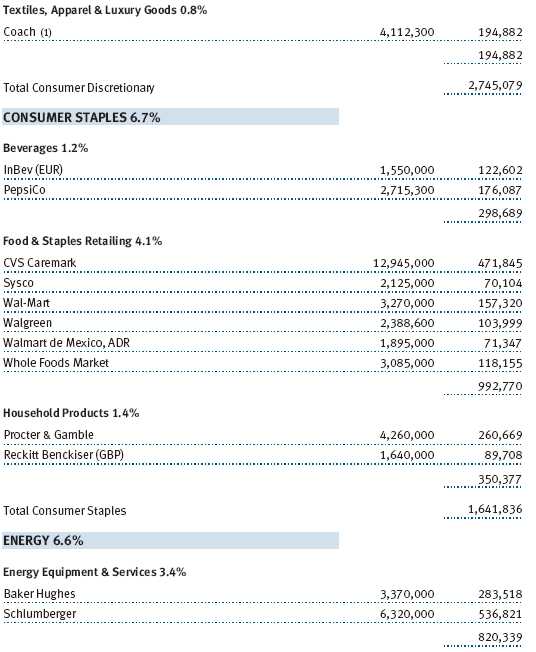







The accompanying notes are an integral part of these financial statements.
Unaudited
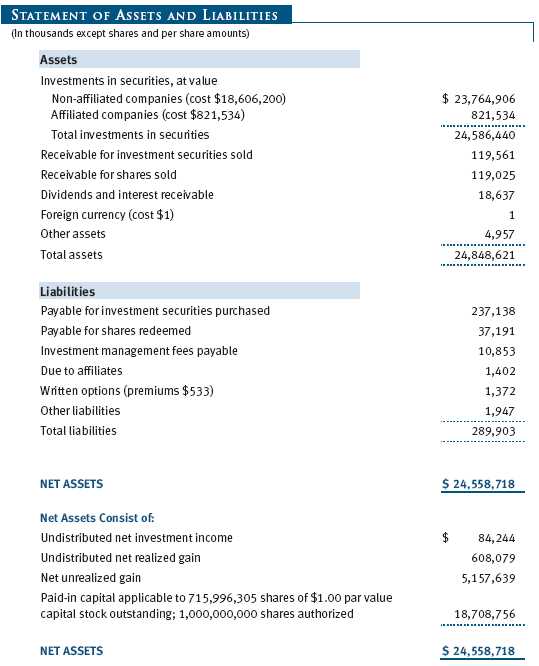

The accompanying notes are an integral part of these financial statements.
Unaudited


The accompanying notes are an integral part of these financial statements.
Unaudited

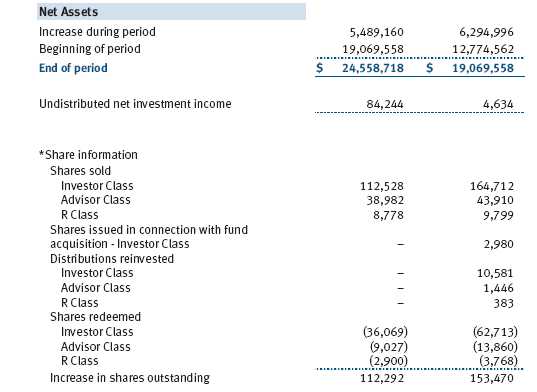
The accompanying notes are an integral part of these financial statements.
Unaudited
| NOTES TO FINANCIAL STATEMENTS |
NOTE 1 - SIGNIFICANT ACCOUNTING POLICIES
T. Rowe Price Growth Stock Fund, Inc. (the fund), is registered under the Investment Company Act of 1940 (the 1940 Act) as a diversified, open-end management investment company. The fund seeks to provide long-term capital growth and, secondarily, increasing dividend income through investments in the common stocks of well-established growth companies. The fund has three classes of shares: the Growth Stock Fund original share class, referred to in this report as the Investor Class, offered since April 11, 1950; the Growth Stock Fund—Advisor Class (Advisor Class), offered since December 31, 2001; and the Growth Stock Fund—R Class (R Class), offered since September 30, 2002. Advisor Class shares are sold only through unaffiliated brokers and other unaffiliated financial intermediaries, and R Class shares are available to retirement plans serviced by intermediaries. The Advisor Class and R Class each operate under separate Board-approved Rule 12b-1 plans, pursuant to which each class compensates financial intermediaries for distribution, shareholder servicing, and/or certain administrative services. Each class has exclusive voting rights on matters related solely to that class, separate voting rights on matters that relate to all classes, and, in all other respects, the same rights and obligations as the other classes.
The accompanying financial statements were prepared in accordance with accounting principles generally accepted in the United States of America, which require the use of estimates made by fund management. Fund management believes that estimates and security valuations are appropriate; however, actual results may differ from those estimates, and the security valuations reflected in the financial statements may differ from the value the fund ultimately realizes upon sale of the securities.
Valuation The fund values its investments and computes its net asset value per share at the close of the New York Stock Exchange (NYSE), normally 4 p.m. ET, each day that the NYSE is open for business. Equity securities listed or regularly traded on a securities exchange or in the over-the-counter (OTC) market are valued at the last quoted sale price or, for certain markets, the official closing price at the time the valuations are made, except for OTC Bulletin Board securities, which are valued at the mean of the latest bid and asked prices. A security that is listed or traded on more than one exchange is valued at the quotation on the exchange determined to be the primary market for such security. Listed securities not traded on a particular day are valued at the mean of the latest bid and asked prices for domestic securities and the last quoted sale price for international securities.
Investments in mutual funds are valued at the mutual fund’s closing net asset value per share on the day of valuation. Purchased and written options are valued at the mean of the closing bid and asked prices.
Other investments, including restricted securities, and those for which the above valuation procedures are inappropriate or are deemed not to reflect fair value are stated at fair value as determined in good faith by the T. Rowe Price Valuation Committee, established by the fund’s Board of Directors.
Most foreign markets close before the close of trading on the NYSE. If the fund determines that developments between the close of a foreign market and the close of the NYSE will, in its judgment, materially affect the value of some or all of its portfolio securities, which in turn will affect the fund’s share price, the fund will adjust the previous closing prices to reflect the fair value of the securities as of the close of the NYSE, as determined in good faith by the T. Rowe Price Valuation Committee, established by the fund’s Board of Directors. A fund may also fair value securities in other situations, such as when a particular foreign market is closed but the fund is open. In deciding whether to make fair value adjustments, the fund reviews a variety of factors, including developments in foreign markets, the performance of U.S. securities markets, and the performance of instruments trading in U.S. markets that represent foreign securities and baskets of foreign securities. The fund uses outside pricing services to provide it with closing market prices and information used for adjusting those prices. The fund cannot predict when and how often it will use closing prices and when it will adjust those prices to reflect fair value. As a means of evaluating its fair value process, the fund routinely compares closing market prices, the next day’s opening prices in the same markets, and adjusted prices.
Currency Translation Assets, including investments, and liabilities denominated in foreign currencies are translated into U.S. dollar values each day at the prevailing exchange rate, using the mean of the bid and asked prices of such currencies against U.S. dollars as quoted by a major bank. Purchases and sales of securities, income, and expenses are translated into U.S. dollars at the prevailing exchange rate on the date of the transaction. The effect of changes in foreign currency exchange rates on realized and unrealized security gains and losses is reflected as a component of security gains and losses.
Class Accounting The Advisor Class and R Class each pay distribution, shareholder servicing, and/or certain administrative expenses in the form of Rule 12b-1 fees, in an amount not exceeding 0.25% and 0.50%, respectively, of the class’s average daily net assets. Shareholder servicing, prospectus, and shareholder report expenses incurred by each class are charged directly to the class to which they relate. Expenses common to all classes, investment income, and realized and unrealized gains and losses are allocated to the classes based upon the relative daily net assets of each class.
Rebates and Credits Subject to best execution, the fund may direct certain security trades to brokers who have agreed to rebate a portion of the related brokerage commission to the fund in cash. Commission rebates are reflected as realized gain on securities in the accompanying financial statements and totaled $280,000 for the six months ended June 30, 2007. Additionally, the fund earns credits on temporarily uninvested cash balances at the custodian that reduce the fund’s custody charges. Custody expense in the accompanying financial statements is presented before reduction for credits, which are reflected as expenses paid indirectly.
Investment Transactions, Investment Income, and Distributions Income and expenses are recorded on the accrual basis. Dividends received from mutual fund investments are reflected as dividend income; capital gain distributions are reflected as realized gain/loss. Dividend income and capital gain distributions are recorded on the ex-dividend date. Any income tax-related interest and penalties would be classified as income tax expense. Investment transactions are accounted for on the trade date. Realized gains and losses are reported on the identified cost basis. Distributions to shareholders are recorded on the ex-dividend date. Income distributions are declared and paid by each class on an annual basis. Capital gain distributions, if any, are declared and paid by the fund, typically on an annual basis.
New Accounting Pronouncements Effective June 29, 2007, the fund adopted Financial Accounting Standards Board (“FASB”) Interpretation No. 48 (“FIN 48”), Accounting for Uncertainty in Income Taxes, a clarification of FASB Statement No. 109, Accounting for Income Taxes. FIN 48 establishes financial accounting and disclosure requirements for recognition and measurement of tax positions taken or expected to be taken on an income tax return. The adoption of FIN 48 had no impact on the fund’s net assets or results of operations.
In September 2006, the FASB released the Statement of Financial Accounting Standard No. 157 (“FAS 157”), Fair Value Measurements. FAS 157 clarifies the definition of fair value and establishes the framework for measuring fair value, as well as proper disclosure of this methodology in the financial statements. It will be effective for the fund’s fiscal year beginning January 1, 2008. Management is evaluating the effects of FAS 157; however, it is not expected to have a material impact on the fund’s net assets or results of operations.
NOTE 2 - INVESTMENT TRANSACTIONS
Consistent with its investment objective, the fund engages in the following practices to manage exposure to certain risks or to enhance performance. The investment objective, policies, program, and risk factors of the fund are described more fully in the fund’s prospectus and Statement of Additional Information.
Options Call and put options give the holder the right to purchase or sell, respectively, a security at a specified price on a certain date. Risks arise from possible illiquidity of the options market and from movements in security values. Written options are reflected in the accompanying Statement of Assets and Liabilities at market value. Transactions in options written and related premiums received during the six months ended June 30, 2007, were as follows:
Other Purchases and sales of portfolio securities, other than short-term securities, aggregated $7,071,542,000 and $3,471,657,000, respectively, for the six months ended June 30, 2007.
NOTE 3 - FEDERAL INCOME TAXES
No provision for federal income taxes is required since the fund intends to continue to qualify as a regulated investment company under Subchapter M of the Internal Revenue Code and distribute to shareholders all of its taxable income and gains. Federal income tax regulations differ from generally accepted accounting principles; therefore, distributions determined in accordance with tax regulations may differ in amount or character from net investment income and realized gains for financial reporting purposes. Financial reporting records are adjusted for permanent book/tax differences to reflect tax character. Financial records are not adjusted for temporary differences. The amount and character of tax-basis distributions and composition of net assets are finalized at fiscal year-end; accordingly, tax-basis balances have not been determined as of June 30, 2007.
The fund intends to retain realized gains to the extent of available capital loss carryforwards. As of December 31, 2006, the fund had $18,224,000 of unused capital loss carryforwards, of which $10,934,000 expire in 2009, $3,645,000 expire in 2010, and $3,645,000 expire in 2011.
At June 30, 2007, the cost of investments for federal income tax purposes was $19,427,734,000. Net unrealized gain aggregated $5,157,639,000 at period-end, of which $5,329,108,000 related to appreciated investments and $171,469,000 related to depreciated investments.
NOTE 4 - FOREIGN TAXES
The fund is subject to foreign income taxes imposed by certain countries in which it invests. Additionally, capital gains realized by the fund upon disposition of securities issued in or by certain foreign countries are subject to capital gains tax imposed by those countries. Similarly, a tax on net profits, including interest income and realized and unrealized capital gains, is imposed by certain other countries. All taxes are computed in accordance with the applicable foreign tax law, and, to the extent permitted, capital losses are used to offset capital gains. Tax expense attributable to income is accrued by the fund as a reduction of income. Current and deferred tax expense attributable to net capital gains is reflected as a component of realized and/or change in unrealized gain/loss on securities in the accompanying financial statements. At June 30, 2007, the fund had no taxes payable attributable to foreign securities, no deferred tax liability attributable to foreign securities, and $3,2 67,000 of foreign capital loss carryforwards that expire in 2013.
NOTE 5 - ACQUISITION
On June 19, 2006, the fund acquired substantially all of the assets of the Preferred Large Cap Growth Fund (the acquired fund), pursuant to the Agreement and Plan of Reorganization dated February 15, 2006, and approved by shareholders of the acquired fund on June 9, 2006. The acquisition was accomplished by a tax-free exchange of 2,979,781 shares of the fund (with a value of $83,464,000) for all 7,056,568 shares of the acquired fund outstanding on June 16, 2006 with the same value. The net assets of the acquired fund at that date included $6,324,000 of unrealized appreciation and $20,171,000 of net realized losses carried forward for tax purposes to offset distributable gains realized by the fund in the future. Net assets of the acquired fund were combined with those of the fund, resulting in aggregate net assets of $12,226,750,000 immediately after the acquisition.
NOTE 6 - RELATED PARTY TRANSACTIONS
The fund is managed by T. Rowe Price Associates, Inc. (the manager or Price Associates), a wholly owned subsidiary of T. Rowe Price Group, Inc. The investment management agreement between the fund and the manager provides for an annual investment management fee, which is computed daily and paid monthly. The fee consists of an individual fund fee and a group fee. The individual fund fee is equal to 0.25% of the fund’s average daily net assets up to $15 billion and 0.21% of the fund’s average daily net assets in excess of $15 billion. The group fee rate is calculated based on the combined net assets of certain mutual funds sponsored by Price Associates (the group) applied to a graduated fee schedule, with rates ranging from 0.48% for the first $1 billion of assets to 0.285% for assets in excess of $220 billion. The fund’s group fee is determined by applying the group fee rate to the fund’s average daily net assets. At June 30, 2007, the effective annual group fee rate was 0 .30%.
In addition, the fund has entered into service agreements with Price Associates and two wholly owned subsidiaries of Price Associates (collectively, Price). Price Associates computes the daily share prices and provides certain other administrative services to the fund. T. Rowe Price Services, Inc., provides shareholder and administrative services in its capacity as the fund’s transfer and dividend disbursing agent. T. Rowe Price Retirement Plan Services, Inc., provides subaccounting and recordkeeping services for certain retirement accounts invested in the Investor Class and R Class. For the six months ended June 30, 2007, expenses incurred pursuant to these service agreements were $76,000 for Price Associates, $1,512,000 for T. Rowe Price Services, Inc., and $2,653,000 for T. Rowe Price Retirement Plan Services, Inc. The total amount payable at period-end pursuant to these service agreements is reflected as Due to Affiliates in the accompanying financial statements.
The fund is also one of several mutual funds sponsored by Price Associates (underlying Price funds) in which the T. Rowe Price Spectrum Funds (Spectrum Funds) and T. Rowe Price Retirement Funds (Retirement Funds) may invest. Neither the Spectrum Funds nor the Retirement Funds invest in the underlying Price funds for the purpose of exercising management or control. Pursuant to separate special servicing agreements, expenses associated with the operation of the Spectrum and Retirement Funds are borne by each underlying Price fund to the extent of estimated savings to it and in proportion to the average daily value of its shares owned by the Spectrum and Retirement Funds, respectively. Expenses allocated under these agreements are reflected as shareholder servicing expenses in the accompanying financial statements. For the six months ended June 30, 2007, the fund was allocated $496,000 of Spectrum Funds’ expenses and $4,638,000 of Retirement Funds’ expenses. Of these amounts, $3,928,000 related to services provided by Price. The amount payable at period-end pursuant to this agreement is reflected as Due to Affiliates in the accompanying financial statements. At June 30, 2007, approximately 4% of the outstanding shares of the Investor Class were held by the Spectrum Funds and 23% were held by the Retirement Funds.
The fund may invest in the T. Rowe Price Reserve Investment Fund and the T. Rowe Price Government Reserve Investment Fund (collectively, the T. Rowe Price Reserve Investment Funds), open-end management investment companies managed by Price Associates and affiliates of the fund. The T. Rowe Price Reserve Investment Funds are offered as cash management options to mutual funds, trusts, and other accounts managed by Price Associates and/or its affiliates, and are not available for direct purchase by members of the public. The T. Rowe Price Reserve Investment Funds pay no investment management fees. During the six months ended June 30, 2007, dividend income from the T. Rowe Price Reserve Investment Funds totaled $19,364,000, and the value of shares of the T. Rowe Price Reserve Investment Funds held at June 30, 2007, and December 31, 2006, was $821,534,000 and $628,576,000, respectively.
As of June 30, 2007, T. Rowe Price Group, Inc. and/or its wholly owned subsidiaries owned 1,580,260 shares of the Investor Class, aggregating less than 1% of the fund’s net assets.
| INFORMATION ON PROXY VOTING POLICIES, PROCEDURES, AND RECORDS |
A description of the policies and procedures used by T. Rowe Price funds and portfolios to determine how to vote proxies relating to portfolio securities is available in each fund’s Statement of Additional Information, which you may request by calling 1-800-225-5132 or by accessing the SEC’s Web site, www.sec.gov. The description of our proxy voting policies and procedures is also available on our Web site, www.troweprice.com. To access it, click on the words “Company Info” at the top of our homepage for individual investors. Then, in the window that appears, click on the “Proxy Voting Policy” navigation button in the top left corner.
Each fund’s most recent annual proxy voting record is available on our Web site and through the SEC’s Web site. To access it through our Web site, follow the directions above, then click on the words “Proxy Voting Record” at the bottom of the Proxy Voting Policy page.
| HOW TO OBTAIN QUARTERLY PORTFOLIO HOLDINGS |
The fund files a complete schedule of portfolio holdings with the Securities and Exchange Commission for the first and third quarters of each fiscal year on Form N-Q. The fund’s Form N-Q is available electronically on the SEC’s Web site (www.sec.gov); hard copies may be reviewed and copied at the SEC’s Public Reference Room, 450 Fifth St. N.W., Washington, DC 20549. For more information on the Public Reference Room, call 1-800-SEC-0330.
| APPROVAL OF INVESTMENT MANAGEMENT AGREEMENT |
On March 7, 2007, the fund’s Board of Directors (Board) unanimously approved the investment advisory contract (Contract) between the fund and its investment manager, T. Rowe Price Associates, Inc. (Manager). The Board considered a variety of factors in connection with its review of the Contract, also taking into account information provided by the Manager during the course of the year, as discussed below:
Services Provided by the Manager
The Board considered the nature, quality, and extent of the services provided to the fund by the Manager. These services included, but were not limited to, management of the fund’s portfolio and a variety of related activities, as well as financial and administrative services, reporting, and communications. The Board also reviewed the background and experience of the Manager’s senior management team and investment personnel involved in the management of the fund. The Board concluded that it was satisfied with the nature, quality, and extent of the services provided by the Manager.
Investment Performance of the Fund
The Board reviewed the fund’s average annual total return over the 1-, 3-, 5-, and 10-year periods as well as the fund’s year-by-year returns and compared these returns with previously agreed upon comparable performance measures and market data, including those supplied by Lipper and Morningstar, which are independent providers of mutual fund data. On the basis of this evaluation and the Board’s ongoing review of investment results, the Board concluded that the fund’s performance was satisfactory.
Costs, Benefits, Profits, and Economies of Scale
The Board reviewed detailed information regarding the revenues received by the Manager under the Contract and other benefits that the Manager (and its affiliates) may have realized from its relationship with the fund, including research received under “soft dollar” agreements. The Board noted that soft dollars were not used to pay for third-party, non-broker research. The Board also received information on the estimated costs incurred and profits realized by the Manager and its affiliates from advising T. Rowe Price mutual funds, as well as estimates of the gross profits realized from managing the fund in particular. The Board concluded that the Manager’s profits were reasonable in light of the services provided to the fund. The Board also considered whether the fund or other funds benefit under the fee levels set forth in the Contract from any economies of scale realized by the Manager. Under the Contract, the fund pays a fee to the Manager composed of two components—a group fee rate based on the aggregate assets of certain T. Rowe Price mutual funds (including the fund) that declines at certain asset levels and an individual fund fee rate that is assessed on the assets of the fund. The Board concluded that the advisory fee structure for the fund continued to provide for a reasonable sharing of benefits from any economies of scale with the fund’s investors.
Fees
The Board reviewed the fund’s management fee rate, operating expenses, and total expense ratio (for the Investor Class, Advisor Class, and R Class) and compared them with fees and expenses of other comparable funds based on information and data supplied by Lipper. The information provided to the Board indicated that the fund’s management fee rate for all three classes and expense ratio for the Investor Class and Advisor Class were at or below the median for comparable funds. The information also indicated that the fund’s expense ratio for the R Class was above the median for comparable funds. The Board also reviewed the fee schedules for comparable privately managed accounts of the Manager and its affiliates. Management informed the Board that the Manager’s responsibilities for privately managed accounts are more limited than its responsibilities for the fund and other T. Rowe Price mutual funds that it or its affiliates advise. On the basis of the information provided, the Board concluded that the fees paid by the fund under the Contract were reasonable.
Approval of the Contract
As noted, the Board approved the continuation of the Contract. No single factor was considered in isolation or to be determinative to the decision. Rather, the Board concluded, in light of a weighting and balancing of all factors considered, that it was in the best interests of the fund to approve the continuation of the Contract, including the fees to be charged for services thereunder.
Item 2. Code of Ethics.
A code of ethics, as defined in Item 2 of Form N-CSR, applicable to its principal executive officer, principal financial officer, principal accounting officer or controller, or persons performing similar functions is filed as an exhibit to the registrant’s annual Form N-CSR. No substantive amendments were approved or waivers were granted to this code of ethics during the registrant’s most recent fiscal half-year.
Item 3. Audit Committee Financial Expert.
Disclosure required in registrant’s annual Form N-CSR.
Item 4. Principal Accountant Fees and Services.
Disclosure required in registrant’s annual Form N-CSR.
Item 5. Audit Committee of Listed Registrants.
Not applicable.
Item 6. Schedule of Investments.
Not applicable. The complete schedule of investments is included in Item 1 of this Form N-CSR.
Item 7. Disclosure of Proxy Voting Policies and Procedures for Closed-End Management Investment Companies.
Not applicable.
Item 8. Portfolio Managers of Closed-End Management Investment Companies.
Not applicable.
Item 9. Purchases of Equity Securities by Closed-End Management Investment Company and Affiliated Purchasers.
Not applicable.
Item 10. Submission of Matters to a Vote of Security Holders.
Not applicable.
Item 11. Controls and Procedures.
(a) The registrant’s principal executive officer and principal financial officer have evaluated the registrant’s disclosure controls and procedures within 90 days of this filing and have concluded that the registrant’s disclosure controls and procedures were effective, as of that date, in ensuring that information required to be disclosed by the registrant in this Form N-CSR was recorded, processed, summarized, and reported timely.
(b) The registrant’s principal executive officer and principal financial officer are aware of no change in the registrant’s internal control over financial reporting that occurred during the registrant’s second fiscal quarter covered by this report that has materially affected, or is reasonably likely to materially affect, the registrant’s internal control over financial reporting.
Item 12. Exhibits.(a)(1) The registrant’s code of ethics pursuant to Item 2 of Form N-CSR is filed with the registrant’s annual Form N-CSR.
(2) Separate certifications by the registrant's principal executive officer and principal financial officer, pursuant to Section 302 of the Sarbanes-Oxley Act of 2002 and required by Rule 30a-2(a) under the Investment Company Act of 1940, are attached.
(3) Written solicitation to repurchase securities issued by closed-end companies: not applicable.
(b) A certification by the registrant's principal executive officer and principal financial officer, pursuant to Section 906 of the Sarbanes-Oxley Act of 2002 and required by Rule 30a-2(b) under the Investment Company Act of 1940, is attached.
| | |
SIGNATURES |
| |
| | Pursuant to the requirements of the Securities Exchange Act of 1934 and the Investment |
| Company Act of 1940, the registrant has duly caused this report to be signed on its behalf by the |
| undersigned, thereunto duly authorized. |
| |
| T. Rowe Price Growth Stock Fund, Inc. |
| |
| |
| By | /s/ Edward C. Bernard |
| | Edward C. Bernard |
| | Principal Executive Officer |
| |
| Date | August 17, 2007 |
| |
| |
| |
| | Pursuant to the requirements of the Securities Exchange Act of 1934 and the Investment |
| Company Act of 1940, this report has been signed below by the following persons on behalf of |
| the registrant and in the capacities and on the dates indicated. |
| |
| |
| By | /s/ Edward C. Bernard |
| | Edward C. Bernard |
| | Principal Executive Officer |
| |
| Date | August 17, 2007 |
| |
| |
| |
| By | /s/ Joseph A. Carrier |
| | Joseph A. Carrier |
| | Principal Financial Officer |
| |
| Date | August 17, 2007 |








